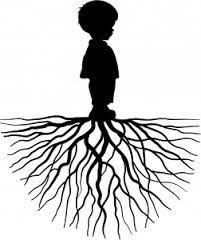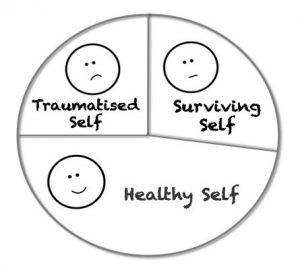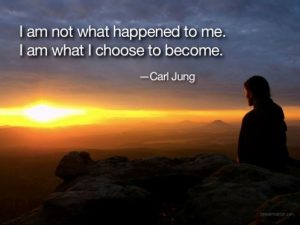Overview
 I have long been fascinated by the subject of child development, particularly how we are shaped growing up and how much potential there is to make changes as adults if as individuals we had a less than “good enough” experience. I am especially interested where people have faced early trauma, whether this marks them for life or there are redemptive traits that they can develop and change, independently through self awareness and along with the help of others; and yes, there is an element of autobiography in this interest.
I have long been fascinated by the subject of child development, particularly how we are shaped growing up and how much potential there is to make changes as adults if as individuals we had a less than “good enough” experience. I am especially interested where people have faced early trauma, whether this marks them for life or there are redemptive traits that they can develop and change, independently through self awareness and along with the help of others; and yes, there is an element of autobiography in this interest.
A dictionary definition of trauma defines it as a as “a deeply distressing or disturbing experience”. Defined like that the events which can be considered traumatic are wide ranging indeed – from what might be considered the general things in life such as divorce, illness, accidents and bereavement to extreme experiences of war, torture, and genocide. This is a wide ranging definition which includes natural events like accidents, and earthquakes where the individual is impacted through something they have no control. Some people would argue that trauma also includes “smaller” things that might cause distress to us like a fall out in the family or the disappointment of being passed over for a job. What is sometimes called “relational trauma” is concerned with our relationships with others and could be around bereavement when we someone close to us has died. It also covers developmental trauma: if our primary attachments with parents or care givers are good, we see ourselves as lovable, but if not, we see ourselves as unlovable and the world as hostile. I find the whole area of developmental trauma the most interesting, as therein lay the challenge for me and my own experience of trauma, and how the early attachment experience influences us throughout our lives.
What seems to happen is our lives become organised around the trauma experience and the fear of re-living it. Our answer is to dissociate from our emotions and any parts of ourselves that arouse disapproval; effectively to cut off from our feelings, both good and bad. Along with this disconnection comes shame, an embodied sense of being fundamentally defective; Brene Brown talks about this sense of shame in her wonderful TED talk. Some therapists and academics believe that there are repeating patterns through generations, that repeat and permeate us through what has happened to our parents to and in turn what happened to their parents, something which Constellations theory in particular emphasises. The other interesting thing about trauma is that it is primarily unconscious; we just know life is a struggle, and for some people “an omnipresent haze of anxiety”. On this basis, we can stay stuck in it forever, or know that there is something going on underneath, but decide the current structure (what I call our self built scaffolding) works well enough for us to cope with life.
 Modern psychotherapy and neurobiology has some links with the original work of Freud and Jung, and specifically related to childhood, the pioneering work of Bowlby, Winnecott and others in the 1950s and 1960s. Bowlby’s view was that children came into the world biologically pre-programmed to form instinctive attachment with others, especially their primary care giver, and that there were long term consequences if there was deprivation of care for the child. Both Bowlby and Winnecott were trained in Freudian theory, but Bowlby departed from Freud in stressing the fundamental importance of the infant’s search for connectedness rather than the idea that individuals respond intuitively to a series of pleasures and desires. One of Bowlby’s key principles was the need for a child to have a “secure base” in the world and a sense that their early experience of attachment becomes internalised as a working model. It is always interesting to note the biographical aspect of people doing this work; Bowlby had a preoccupied Mother and a remote Father, and was sent off to Boarding school early in his life.
Modern psychotherapy and neurobiology has some links with the original work of Freud and Jung, and specifically related to childhood, the pioneering work of Bowlby, Winnecott and others in the 1950s and 1960s. Bowlby’s view was that children came into the world biologically pre-programmed to form instinctive attachment with others, especially their primary care giver, and that there were long term consequences if there was deprivation of care for the child. Both Bowlby and Winnecott were trained in Freudian theory, but Bowlby departed from Freud in stressing the fundamental importance of the infant’s search for connectedness rather than the idea that individuals respond intuitively to a series of pleasures and desires. One of Bowlby’s key principles was the need for a child to have a “secure base” in the world and a sense that their early experience of attachment becomes internalised as a working model. It is always interesting to note the biographical aspect of people doing this work; Bowlby had a preoccupied Mother and a remote Father, and was sent off to Boarding school early in his life.
“Young children, who for whatever reason are deprived of the continuous care and attention of a mother or a substitute-mother, are not only temporarily disturbed by such deprivation, but may in some cases suffer long-term effects which persist”.
Modern neuroscience approaches
In the trauma literature, therapists like Peter Levine and Bessel Van der Kolk note that there is a recurring theme of re-creating familiar patterns as adults that we learnt early in life where we haven’t made connection with our primary care givers and we stay at least partially cut off from and disconnected from others as adults. My own experience of early trauma led me to in my teens and twenties to follow familiar behavioural patterns and switch off from my body and intuition and dissociate.
 In Dan Siegel’s Mindsight book, he describes “mindsight” as having insight to oneself, understanding and empathy with others, and a level of integration with oneself and others. In his earlier work The Developing Mind, Siegel makes the explicit connection between good attachment being directly linked to the neural growth of the brain: “these salient emotional relationships have a direct affect on the development of the domains of mental functioning that serve as our conceptual anchor points: memory, narrative, emotion, representations and states of mind. In this way attachment relationships may serve to create the central foundation from which the mind develops”. What I like is the way he illustrates the limitations of the words we use and that a verbal exchange “may feel quite empty if it is devoid of the more primary aspects of each person’s interpersonal states”; the need for attunement with others persists throughout our lives in our close relationships and the wider world.
In Dan Siegel’s Mindsight book, he describes “mindsight” as having insight to oneself, understanding and empathy with others, and a level of integration with oneself and others. In his earlier work The Developing Mind, Siegel makes the explicit connection between good attachment being directly linked to the neural growth of the brain: “these salient emotional relationships have a direct affect on the development of the domains of mental functioning that serve as our conceptual anchor points: memory, narrative, emotion, representations and states of mind. In this way attachment relationships may serve to create the central foundation from which the mind develops”. What I like is the way he illustrates the limitations of the words we use and that a verbal exchange “may feel quite empty if it is devoid of the more primary aspects of each person’s interpersonal states”; the need for attunement with others persists throughout our lives in our close relationships and the wider world.
Looking more specifically at the world of trauma in childhood development, Bessel van der Kolk has spent over three decades working with survivors who have faced in many cases extreme trauma. In The Body Keeps the Score, he uses recent scientific advances to show how trauma literally reshapes both body and brain, compromising sufferer’s capacities for pleasure, and to authentically engage and trust others around them. The second half of the book explores innovative treatments on the strong redemptive basis that some of these scars can be overcome by activating the brains natural neuroplasticity. I felt moved by this book and learnt a lot about how trauma comes to become part of the body and can stay with people through the life cycle unless they understand and learn to know it has passed, and practice self compassion.
 Perhaps the most fundamental area where modern childhood development theories show the fundamental part poor attachment plays is what happens when people have experienced trauma. Trauma produces actual physiological changes in the brain. Sufferers of severe trauma develop a chronic vigilance for and sensitivity to threat, which can stay throughout the life cycle of the individual unless they learn to understand that the danger has passed. He talks about their trauma becoming their sole sense of meaning and asks are “people with trauma condemned to seek refuge in the familiar?” He goes on to say “research from the new disciplines has revealed that trauma produces actual physiological changes, including a re-calibration of the brain’s alarm system. People who have faced severe trauma under stress take longer to return to baseline behaviour, and spike more suddenly and disproportionately when tough events happen in their lives. We have heard many times in neuroscience the recent discovery that “brain neurones that fire together wire together”: emotions for a trauma sufferer like fear and abandonment or self loathing get fired up continually and habitually when things go wrong. The other aspect of facing trauma is that it is hard enough to face the suffering inflicted by others, but deep down trauma is more haunting because of the shame about what the individual didn’t do to avoid it, for being terrified of it, especially if it was at the hands of the primary caregiver. Individuals often can’t find the words to blame their care givers so blame it on themselves and create dissociation and splitting in order to push the trauma away. Siegel develops this point further in the idea of “over pruning” in childhood trauma where stress hormones kill the neurons in the crucial pathways of the neocortex and limbic system-the area responsible for emotional regulation.
Perhaps the most fundamental area where modern childhood development theories show the fundamental part poor attachment plays is what happens when people have experienced trauma. Trauma produces actual physiological changes in the brain. Sufferers of severe trauma develop a chronic vigilance for and sensitivity to threat, which can stay throughout the life cycle of the individual unless they learn to understand that the danger has passed. He talks about their trauma becoming their sole sense of meaning and asks are “people with trauma condemned to seek refuge in the familiar?” He goes on to say “research from the new disciplines has revealed that trauma produces actual physiological changes, including a re-calibration of the brain’s alarm system. People who have faced severe trauma under stress take longer to return to baseline behaviour, and spike more suddenly and disproportionately when tough events happen in their lives. We have heard many times in neuroscience the recent discovery that “brain neurones that fire together wire together”: emotions for a trauma sufferer like fear and abandonment or self loathing get fired up continually and habitually when things go wrong. The other aspect of facing trauma is that it is hard enough to face the suffering inflicted by others, but deep down trauma is more haunting because of the shame about what the individual didn’t do to avoid it, for being terrified of it, especially if it was at the hands of the primary caregiver. Individuals often can’t find the words to blame their care givers so blame it on themselves and create dissociation and splitting in order to push the trauma away. Siegel develops this point further in the idea of “over pruning” in childhood trauma where stress hormones kill the neurons in the crucial pathways of the neocortex and limbic system-the area responsible for emotional regulation.
” these changes explain why traumatised individuals become hyper vigilant to threat at the expense of spontaneously engaging in their day to day lives. They also help us understand why traumatised people so often keep repeating the same problems and have such trouble learning from experience”.
Creating the self care system; the work of Vivien Broughton
 Vivien Broughton is a Constellations therapist who focuses most of her work in trauma. She identifies the creation of a self care system created by the child as a life saving system to be able to withdraw from the world psychologically, in what is known as dissociation where we split aspects of our personality. We think that the lack of connection with our parents must be our fault and if only we could become good enough for our parents, the pain will stop and we will be loveable. The problem with this scaffolding is that the child sees danger in the very opportunities that could bring healing; the saving self of our personality creates a vicious inner critic that becomes well entrenched as a dual role of critic and protector. Surviving trauma in the moment of the traumatic event depends on the psychological and physiological splitting off of the trauma experience, which then becomes unconscious. This happens through a freeze and fragmenting process which comes into play when the high stress response of fight or flight fails.
Vivien Broughton is a Constellations therapist who focuses most of her work in trauma. She identifies the creation of a self care system created by the child as a life saving system to be able to withdraw from the world psychologically, in what is known as dissociation where we split aspects of our personality. We think that the lack of connection with our parents must be our fault and if only we could become good enough for our parents, the pain will stop and we will be loveable. The problem with this scaffolding is that the child sees danger in the very opportunities that could bring healing; the saving self of our personality creates a vicious inner critic that becomes well entrenched as a dual role of critic and protector. Surviving trauma in the moment of the traumatic event depends on the psychological and physiological splitting off of the trauma experience, which then becomes unconscious. This happens through a freeze and fragmenting process which comes into play when the high stress response of fight or flight fails.
Some survival strategies are more destructive and serious than others, but in general they are the ways we develop to manage the chaotic and terrifying experiences of the unconscious split off trauma when they threaten to surface (known as re-triggering or retraumatisation). Broadly they allow us to dissociate from the here-and-now situation and distract ourselves from whatever is currently causing the trauma to resurface. Essentially at the time of the original trauma this was life-saving, but later these strategies tend to become limiting, disturbing and even severely self-destructive. It is sometimes the case that what originated as something that saved us, eventually becomes something that will destroy us.
Some of the conditions that we would see as being ways of managing trauma by dissociation and distraction are any kind of addiction including: drug, alcohol, medication, cigarettes, work addiction, gaming, sex addiction, and food addiction. Avoidant behaviour strategies like avoidance of anything that is a challenge, avoidance of intimacy, and difficulty with relationships. Where I have issue with Broughton may be some of the psychological and emotional disorders she includes like eating disorders and different types of depression. However, the model of dissociation and healthy self, trauma self and surviving self I think is a good prism to look at how people deal with trauma.
Conclusion
 The sense from a therapeutic standpoint though is that we can shift over time. Individuals can be quite secure for a period of time but when the attachment needs are triggered say through stress, they go back to an earlier “home” of anxiety that is more familiar. Some people’s secure base is smaller, so attachment is triggered constantly. Siegel notes: “in emotional relationships of many sorts-including romance, close friendships, psychotherapy..there may be aspects of attachment present in which there are the basic elements of seeking proximity, using the other as a safe haven when upset, and internalising the other person as a mental image providing a sense of a secure base”. I personally resonated with Siegel’s idea of “earned secure autonomous status” which for me was reinforced by completing the attachment questionnaire developed by Chris Fraley, which looks at our adult attachment styles in specific relationships. My attachment style in relation to both my parents came out as fearful, most strongly with my Mother. My attachment style with my partner and best friend are both strongly secure; it wasn’t a huge revelation seeing the results of the questionnaire, but more a recognition and reiteration of the distance I have travelled towards a secure base from my childhood experiences. The other key principle I have worked hard at is the inter-generational one; to break the cycle of fear with my two children, and for them to feel secure with us as parents, whilst accepting with humility we have made many mistakes, maybe some of the same ones and maybe some different ones.
The sense from a therapeutic standpoint though is that we can shift over time. Individuals can be quite secure for a period of time but when the attachment needs are triggered say through stress, they go back to an earlier “home” of anxiety that is more familiar. Some people’s secure base is smaller, so attachment is triggered constantly. Siegel notes: “in emotional relationships of many sorts-including romance, close friendships, psychotherapy..there may be aspects of attachment present in which there are the basic elements of seeking proximity, using the other as a safe haven when upset, and internalising the other person as a mental image providing a sense of a secure base”. I personally resonated with Siegel’s idea of “earned secure autonomous status” which for me was reinforced by completing the attachment questionnaire developed by Chris Fraley, which looks at our adult attachment styles in specific relationships. My attachment style in relation to both my parents came out as fearful, most strongly with my Mother. My attachment style with my partner and best friend are both strongly secure; it wasn’t a huge revelation seeing the results of the questionnaire, but more a recognition and reiteration of the distance I have travelled towards a secure base from my childhood experiences. The other key principle I have worked hard at is the inter-generational one; to break the cycle of fear with my two children, and for them to feel secure with us as parents, whilst accepting with humility we have made many mistakes, maybe some of the same ones and maybe some different ones.
 The first few years of childhood have an utterly profound effect on the development of the individual. What modern neuroscience has reinforced are the principles that poor attachment literally changes our brain, and can make us for example hyper vigilant and detached from authentic connection with others. What is also shows us though is the very strong redemptive aspects where poor childhood attachment can be alleviated through the individual agency and reflection of the person, their innate sense of potential to change and the part that strong relationships can potentially play. As Siegel puts it: “if the capacity of the mind to adapt remains into adulthood, then the emotional relationships we have throughout life may be seen as the medium in which further development can be fostered”.
The first few years of childhood have an utterly profound effect on the development of the individual. What modern neuroscience has reinforced are the principles that poor attachment literally changes our brain, and can make us for example hyper vigilant and detached from authentic connection with others. What is also shows us though is the very strong redemptive aspects where poor childhood attachment can be alleviated through the individual agency and reflection of the person, their innate sense of potential to change and the part that strong relationships can potentially play. As Siegel puts it: “if the capacity of the mind to adapt remains into adulthood, then the emotional relationships we have throughout life may be seen as the medium in which further development can be fostered”.
We are still finding out about the whole concept of neuroplasticity, the brain’s ability to adapt and change, but we have a sense that it can work; our minds have an incredible strength to re-wire and create entirely new pathways as well as strengthening pathways of solidity. Conversely, our brains can prune or minimise negative old neural pathways, even if we have to deal with the inherent recidivism of sometimes slipping into old ways. One of the metaphors I personally use is the idea of travelling a different road to the one I grew up in. I have got more and more road under the wheels of security, connectedness and happiness, which I have been on for over 30 years, rather than the old road which I travelled on as a child and young adult.